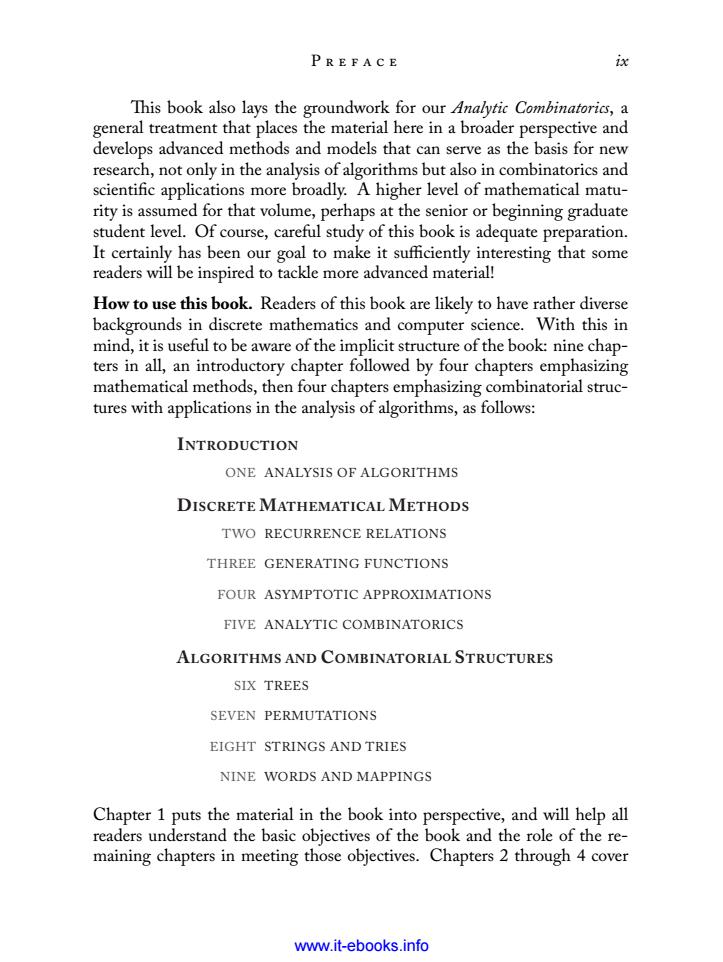正在加载图片...

PREFACE ix This book also lays the groundwork for our Analytic Combinatorics,a general treatment that places the material here in a broader perspective and develops advanced methods and models that can serve as the basis for new research,not only in the analysis of algorithms but also in combinatorics and scientific applications more broadly.A higher level of mathematical matu- rity is assumed for that volume,perhaps at the senior or beginning graduate student level.Of course,careful study of this book is adequate preparation. It certainly has been our goal to make it sufficiently interesting that some readers will be inspired to tackle more advanced material! How to use this book.Readers of this book are likely to have rather diverse backgrounds in discrete mathematics and computer science.With this in mind,it is useful to be aware of the implicit structure of the book:nine chap- ters in all,an introductory chapter followed by four chapters emphasizing mathematical methods,then four chapters emphasizing combinatorial struc- tures with applications in the analysis of algorithms,as follows: INTRODUCTION ONE ANALYSIS OF ALGORITHMS DISCRETE MATHEMATICAL METHODS TWO RECURRENCE RELATIONS THREE GENERATING FUNCTIONS FOUR ASYMPTOTIC APPROXIMATIONS FIVE ANALYTIC COMBINATORICS ALGORITHMS AND COMBINATORIAL STRUCTURES SIX TREES SEVEN PERMUTATIONS EIGHT STRINGS AND TRIES NINE WORDS AND MAPPINGS Chapter 1 puts the material in the book into perspective,and will help all readers understand the basic objectives of the book and the role of the re- maining chapters in meeting those objectives.Chapters 2 through 4 cover www.it-ebooks.infoP Ş ő Œ ō ŏ ő ix Ļis book also lays the groundwork for our Analytic Combinatorics, a general treatment that places the material here in a broader perspective and develops advanced methods and models that can serve as the basis for new research, not only in the analysis of algorithms but also in combinatorics and scientiŀc applications more broadly. A higher level of mathematical maturity is assumed for that volume, perhaps at the senior or beginning graduate student level. Of course, careful study of this book is adequate preparation. It certainly has been our goal to make it sufficiently interesting that some readers will be inspired to tackle more advanced material! How to use this book. Readers of this book are likely to have rather diverse backgrounds in discrete mathematics and computer science. With this in mind, it is useful to be aware of the implicit structure of the book: nine chapters in all, an introductory chapter followed by four chapters emphasizing mathematical methods, then four chapters emphasizing combinatorial structures with applications in the analysis of algorithms, as follows: ANALYSIS OF ALGORITHMS RECURRENCE RELATIONS GENERATING FUNCTIONS ASYMPTOTIC APPROXIMATIONS ANALYTIC COMBINATORICS TREES PERMUTATIONS STRINGS AND TRIES WORDS AND MAPPINGS INTRODUCTION DISCRETE MATHEMATICAL METHODS ALGORITHMS AND COMBINATORIAL STRUCTURES ONE TWO THREE FOUR FIVE SIX SEVEN EIGHT NINE Chapter 1 puts the material in the book into perspective, and will help all readers understand the basic objectives of the book and the role of the remaining chapters in meeting those objectives. Chapters 2 through 4 cover www.it-ebooks.info